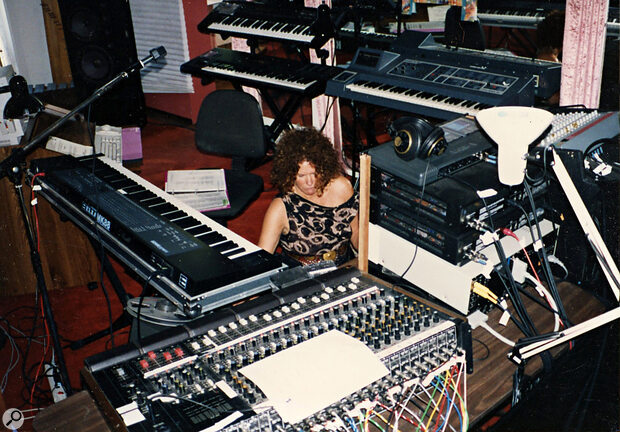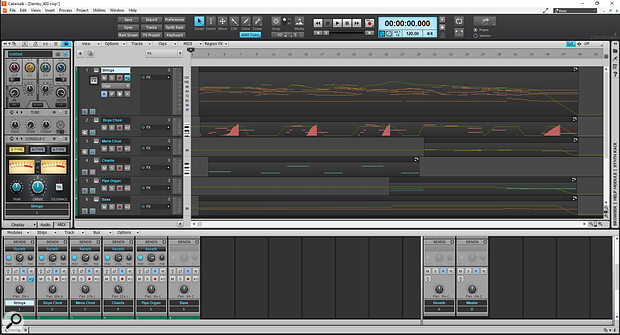 Few photos exist of Constance Demby at work in the studio. This shot presumably dates from the ’80s and features the Emulator II used on Novus Magnificat.Photo: Serwin Media Group
Few photos exist of Constance Demby at work in the studio. This shot presumably dates from the ’80s and features the Emulator II used on Novus Magnificat.Photo: Serwin Media Group
We engage in some audio archaeology to discover how a pioneer of electronic music created one of her most important works.
Constance Demby is often credited with developing the New Age genre with her 1985 album Novus Magnificat: Through The Stargate. She is widely remembered for playing one‑of‑a‑kind instruments of her own design, like the Space Bass and Whale Sail, in astral venues such as the Mt Wilson Observatory and Stonehenge. But what is perhaps less well known is that she was an early adopter of digital music and recording technology, and somewhat of a pioneer in making her own albums in a home studio.
I first became aware of Ms Demby upon hearing her frequently overlooked 2001 album, Sanctum Sanctuorum, my curiosity no doubt piqued by the title and the mysterious deep blue cover imagery. It snuck up on me over the years, becoming an album to which I keep returning. For me, this achingly beautiful music transcends the New Age category and sounds like a classical composition and recording. While the orchestral components are clearly synthesized, the full nature of the production with its choral components led me to think that vocalists had been hired, and the music scored and recorded in a traditional manner. I was therefore very surprised to learn recently that Ms Demby in fact made this album by herself in a home studio using sample libraries while living in an apartment in Spain.
In retrospect, this makes sense. Listening to her prior albums, you can hear the evolution of her relationship with the developing technology of the time. Novus Magnificat was almost entirely Emulator II — a year prior to James Horner’s sampled orchestral soundtrack to The Name Of The Rose. In the mid‑1990s she was using Kurzweil K2000 keyboards to create rich synthesizer soundscapes, and by 2000, with Sanctum Sanctuorum, she was using a DAW to skillfully combine refined, hybrid synth pads and sample libraries. I encourage you to pause here and have a listen to a section from the Sanctum Sanctuorum track, ‘Gateway’. I’ll be focusing on approximately a minute and a half beginning at the 3:40 mark: https://youtu.be/wE_NKmgH_rA?t=219
Digging Deep
According to interviews with Ms Demby, the music of Sanctum Sanctuorum originated with a film soundtrack she recorded, which was released the previous year as Faces Of The Christ. Listening to both albums reveals that much of the musical composition for Sanctum Sanctuorum indeed already existed in the earlier release. Incorporating phrased‑based Gregorian chant and choir samples so organically into previously written music using the tools available in 1999‑2000 seemed noteworthy, and I badly wanted to better understand how she accomplished it. Since I could no longer ask her (Ms Demby passed away in 2021, and she worked mostly alone), I decided to embark on some audio detective work.
 I know what you’re thinking: “Just ask around!” Trust me when I say I asked around. I even tracked down the credited engineer on the album, but he recalled so little — nothing actually about the composition or the recording process — that I have to conclude she worked in isolation.
I know what you’re thinking: “Just ask around!” Trust me when I say I asked around. I even tracked down the credited engineer on the album, but he recalled so little — nothing actually about the composition or the recording process — that I have to conclude she worked in isolation.
So the first step was to see if I could identify the vocal sample libraries she used. I auditioned as many contemporary female choir libraries as I could find demos for, but nothing seemed like a match to the voices on Sanctum Sanctuorum. Then, through an email exchange with another artist associated with Constance, I learned that what I thought were female choir voices was actually a young male choir.
From interviews and photos, I knew that by 2000 Ms Demby was using a Kurzweil K2500XS keyboard and a Power Mac 7300 running Opcode Studio Vision Pro. Given that support for digital audio tracks in Opcode Studio was a new thing, I reasoned that she most likely loaded samples into the K2500XS and used Opcode Studio as a MIDI sequencer. So I searched for choir sample libraries from the late 1990s that came in Kurzweil format and included both Gregorian chants and boys choir, and one that stood out was Symphony Of Voices from Spectrasonics. Since it’s now a legacy product, I emailed Spectrasonics to find out if the library was still available in any form, and was pleasantly surprised when informed that the entire Symphony Of Voices sample set is included with Omnisphere 2, which coincidentally I already own!
Cut to me firing up Omnisphere 2 and locating the legacy Boys Choir ‘oos’ patch. I could tell immediately that it was very likely the same sound used on Sanctum Sanctuorum. Excited, I checked out all of the Gregorian chant phrases in the Omnisphere 2 sample library and... struck out. Thus followed a long period hunting for and auditioning Gregorian chants. Purchasing every possible candidate certainly wasn’t an option, so I had to rely on available demos, knowing that demos don’t include perhaps even the majority of phrases in any given library. Still, nothing seemed to have the right feel.
One day I decided to try limiting my search date range to 1999 and 2000, and on about the third results page, I found a link to the online sample library store, SoundLoad.club, selling a library called Gregorian Monks. The product is described as banks of WAV files along with Kontakt instrument patches. I’m not sure why it showed up using the specified date range, but given the description, I assumed it was an older library repurposed to be Kontakt‑ready. Because it was only $15 and was downloadable, I figured the only thing I had to lose was, well, $15. Surprise! Buried deep in the folder structure were the exact samples used in the above section of ‘Gateway’. Eventually, I found a one‑for‑one match for every Gregorian chant found in both this track and ‘Invocation’.
I’ve since written several emails to SoundLoad.club inquiring about the origins of this library; none have been answered. The package art on the product page bears the name “The Very Best Of Gregorian”, but there’s no way to know if this is original. All I can say for sure is that this sound library existed in 2000 and was likely available in Kurzweil format.
 Another rare image of Constance Demby in her home studio, again pre‑DAW.
Another rare image of Constance Demby in her home studio, again pre‑DAW.
Gateway To The Truth
Armed with the correct vocal samples, I decided to see if I could reproduce a section of ‘Gateway’. This seemed like a logical way, and perhaps the only way, to confirm my theories about how Constance Demby made this album. I built up the piece in Cakewalk by BandLab, my current DAW of choice for historical reasons, using five Omnisphere 2 tracks and one Trilian track.
Track 1 is the strings. To get started, I called up Omnisphere 2’s Adagio Expressive string patch and blocked in the major chord structure of the target section. Ms Demby had a way of playing string pads that my friend, songwriter and guitar player Sam Broussard described as hearing, “each voice disappearing or being added until a new chord is built, but it immediately starts eroding like a sand castle... until a new chord rises”. I’ve seen enough video to know she could play this way live. I’m nowhere near the keyboard player she was, so I had to resort to careful listening and editing. I put aside for later any attempt to match her string sound.
Track 2 is the original Symphony Of Voices Boys Choir from the Omnisphere 2 sound library. In order to replicate the original articulations, I created a patch that uses the mod wheel to smoothly transition between “oos” and “ahs”.
Track 3 is the Symphony Of Voices ‘Choir Men ahs’ patch. This is used sparingly and only appears in the second half of the section.
Track 4 is the Gregorian chant track. I created an Omnisphere 2 multi to position the various phrases across a range of notes. This piece of music was always in the key of C#, as evidenced by her prior album also being in this key, and I’m amazed that Ms Demby was able to find such well suited Gregorian chant samples and use them in their originally recorded notes, without modifying any of the sample pitches.
Track 5 is the Omnisphere 2 ‘Pipe Organ Cathedral’ patch. This is the one component I included that is possibly not in the original piece. I felt it was an appropriate addition regardless, and I could, so I did.
Finally, Track 6 is Trilian with a droning bass using the ‘Dark and Round Voyager’ patch as a foundation.
 Once the right sample libraries had been tracked down, recreating an excerpt from ‘Gateway’ required only six tracks.
Once the right sample libraries had been tracked down, recreating an excerpt from ‘Gateway’ required only six tracks.
With the performance as close to the original as I could reasonably make it, I began dialling in the string sound. Based on interviews, Ms Demby’s strings were likely a custom Kurzweil K2500XS patch, and clearly not just sampled acoustic strings. I created a custom Omnisphere 2 patch that layered four different vintage components from the Spectrasonics sound source library: Prophet Pad, Mellotron Violins, OB‑8 Uni Mama and Hammond Hollow Slow. Adjusting the attack, release and relative volume of these layers got me to something that, if not an exact match, seems quite close.
I removed all Omnisphere 2 reverb for each track and used FX sends to route everything except the Trilian track to a single instance of iZotope Neoverb. Finally, I used iZotope Ozone 9’s Master Assistant to try to match the original reference track’s EQ and dynamics.
It’s easy to forget how new, and much more difficult, this process was back then.
Ms Demby almost certainly did not use Opcode Studio to record and process audio tracks, but more as just a MIDI sequencer. Based on interviews, it’s likely that she rendered the output of her Kurzweil to ADAT in multiple passes using MIDI sync, doing her mixing and mastering with external hardware. It should be noted that with a modern DAW, virtual instruments and plug‑in processing, I had a much easier time of it. In any event, have a listen to the Soundcloud file below, at https://sosm.ag/constance-demby, and decide for yourself if I’ve come close enough for me to say I think I know now how she made this music. Because that’s what I’m saying.
The project itself turns out to be deceptively simple, containing just six MIDI tracks. The complexity and beauty come from Ms Demby’s ability to write and play evolving, flowing string pads covering the entire spectrum, and the magic comes from skillfully incorporating vocal sample libraries to produce something quite organic and natural. It’s easy to forget how new, and much more difficult, this process was back then. To be honest, I was a bit fearful that by uncovering the method by which this beautiful music was constructed, it might lessen my appreciation. On the contrary, I have renewed respect for what Ms Demby accomplished in a home studio circa 2000, and it still fills me with wonder every time I hear it.
